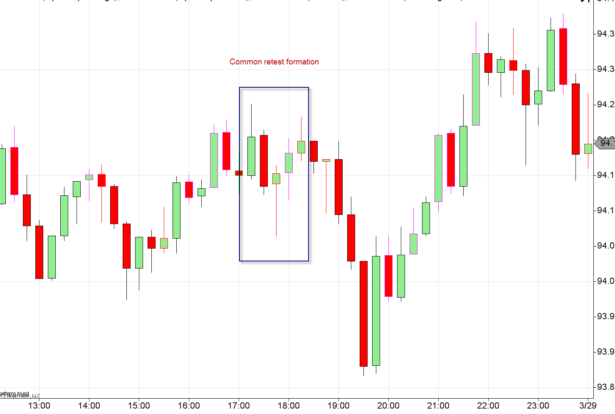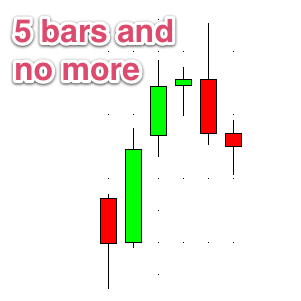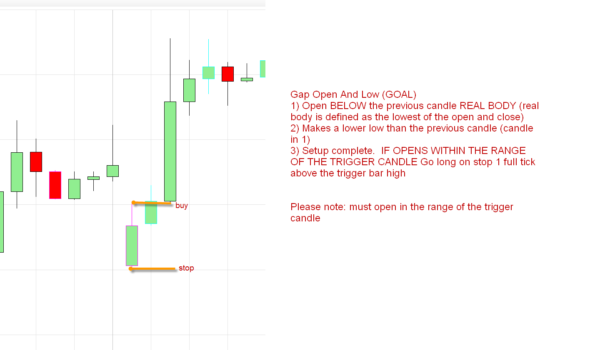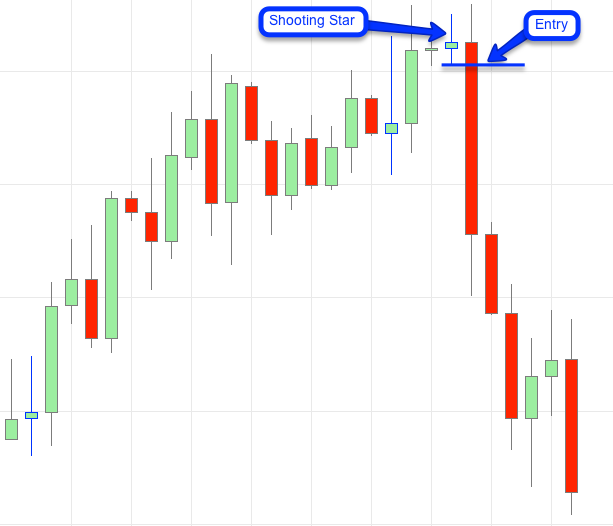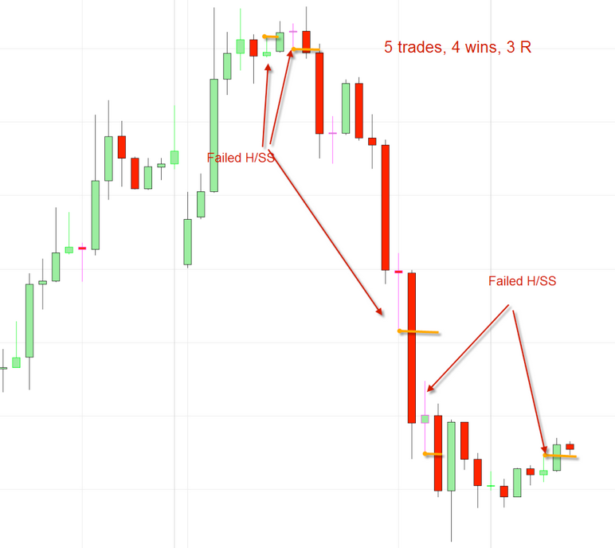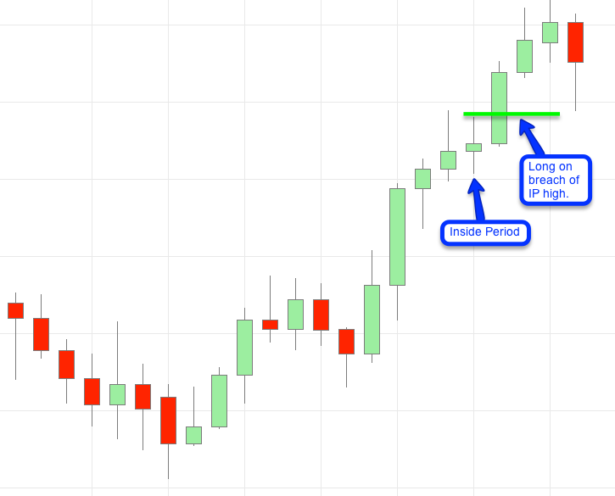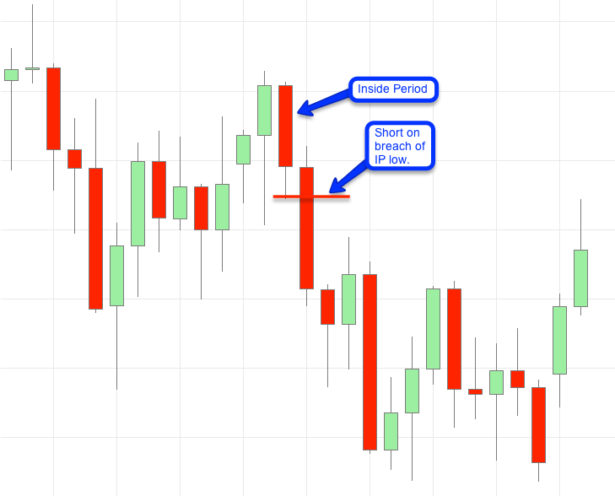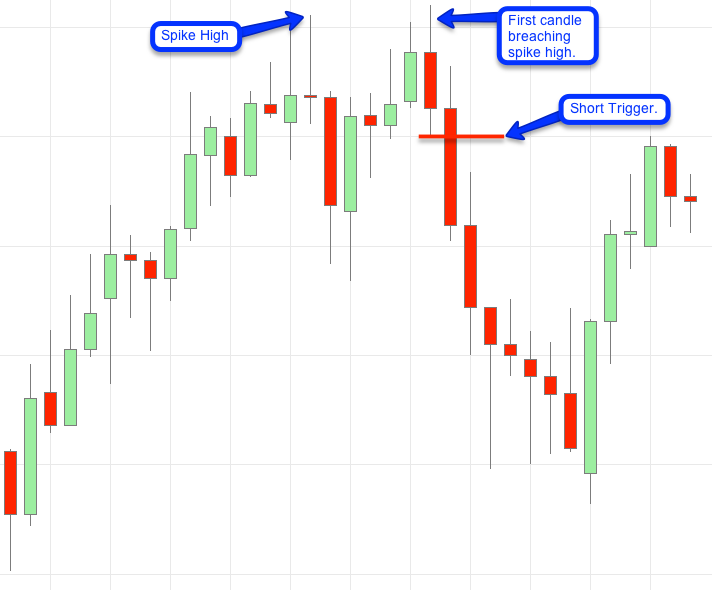Net-Lines:
Net-Line Buy Level (NLBL): Wait for three consecutive lower lows, then take the high of the first candle as your NLBL. The push above that high is your signal to go long. Put a stop a few ticks below the NLBL, preferably at a non-rounded price.
Net-Line Sell Level (NLSL): Wait for three consecutive higher highs, then take the low of the first candle as your NLSL. A breach below that low is your signal to go short. Put a stop a few ticks above the NLSL, preferably at a non-rounded price.
For more details feel free to download this ‘ancient’ 2002 article which covers all the ins and outs. In case you wonder – no I don’t use bull/bear power – I love the name though!
Trend Day:
This indicator triggers every trading day after the 45th minute of the NYSE session (i.e. at 10:15am EST). It measures the percentage of time that the NYSE TICK closes either above or below zero. Once the odds are calculated it will shoot out an alert to the email address listed in your membership profile.
So, why do we care? A HIGH reading, i.e. less than 10% for down and over 90% for up trend days, promises easy money, super reliable 5-min signals. A switched on trader can make his monthly income in one single trend day. Once you get a HIGH alert contrary trades should come off the table (that means no short trades on a HIGH probability Up Trend Day and of course the inverse). We take every 5-min pullback setup, we ignore momo divergences which will get bottom or top pickers in too early. Even Zero Lite divergences should be taken with extra skepticism. The key is getting in on the first 5-min pullback, which will often look too shallow to trade.
Here is our current rating system.
Between >= 90% and <=100%: HIGH probability of a up trend day.
Between >= 80% and < 90%: MODERATE probability of a up trend day.
Between >= 70% and < 80%: LOW probability of a up trend day.
Between >=30% and < 70% Probably not a trend day.
Between <= 30% and > 20%: LOW probability of a down trend
Between <= 20% and >10%: MODERATE probability of a down trend day.
Between <=10% and >=0%: HIGH probability of a down trend day.
VIX Buy/Sell:
For a VIX confirmed signal you need 3 events:
- A close outside of the 2.0 Bollinger Band (20-day SMA)
- A close back inside the 2.0 BB – this issues the signal
- A higher close (sell) or lower close (buy) than the close of the day back inside the 2.0 BB – this confirms the signal.
Once you get those three events a major reversal usually occurs within the next week. The sell signals used to be far more accurate than the buy signals, but in the past two years that relationship has reversed, thus I think it is dependent on the ongoing trend.
CrazyIvan Candle Patterns
Please note that although these price patterns were documented by Ivan Krastins as part of his own trading systems, the definitions we use differ in minor ways from the originals. The reasons we have changed definitions from the original are for simplicity, clarity, and ease of automation.
- Retest Buy (RT-L)
- Retest Sell (RT-S)
- Retest Variation Buy (RTV-L)
- Retest Variation Sell (RTV-S)
- Gap Open Real Body Sell (GARB-L)
- Gap Open Real Body Sell (GARB-S)
- Trend Trade Buy
- Trend Trade Sell
- Hammer
- Shooting Star
- Failed Hammer
- Failed Shooting Star
- Inside Period Long
- Inside Period Short
- Fakeout Long
- Fakeout Short
Retest Buy (RT-L)
- A Spike Low (not necessarily a significant low, just a plain old spike low)
- The next spike of any sort (high or low) is a spike high
- Count the bars between (1) and (2) EXCLUDING the bars that made the spikes. That number is N
- Price cannot break either the low of (1) or the high of (2) or the setup is cancelled (obviously it will likely become a new fakeout setup at that point)
- 5) Price cannot make another spike high or spike low or the setup is cancelled
- 5) After the spike high in 2, at least N+1 bars without breaking the spike low in (1) or the high in (2)
- 6) A hammer candle.
- Setup complete. Buy on stop at High[1] + 1 full tick
Retest Sell (RT-S)
- A Spike High (not necessarily a significant high, just a plain old spike high)
- The next spike of any sort (high or low) is a spike low
- Count the bars between (1) and (2) EXCLUDING the bars that made the spikes. That number is N
- Price cannot break either the high of (1) or the low of (2) or the setup is cancelled (obviously it will likely become a new fakeout setup at that point)
- Price cannot make another spike high or spike low or the setup is cancelled
- After the spike low in 2, at least N+1 bars without breaking the spike high in (1) or the low in (2)
- A shooting star candle.
- Setup complete. Sell on stop at Low[1] – 1 full tick
Examples:
Retest Variation Buy (RTV-L)
- Significant Low: lowest low for 10 bars OR first bar to break an existing Spike Low.
- One or more higher closes.
- One or more lower closes (than the close in 2).
- Setup complete. Buy on stop 1 full tick above the high of the bar that completes the setup.
Rule: If you count back from the ENTRY bar to the spike high, not counting the trigger bar, the count can be a maximum of 5 bars and no more.
Examples
Retest Variation Sell (RTV-S)
- Significant high (highest high for 10 bars OR the first bar to break an existing spike high)
- One or more lower closes (can happen in the same bar)
- One or more higher closes (than the close in 2)
- Setup complete. Sell on stop 1 full tick below the low of the bar that completes the setup. Stop 1 tick above the high.
Note if you count back from the trigger bar to the Spike High that count can be a maximum of 5 bars and no more.
Gap Open Real Body Buy (GARB-L)
- TRIGGER candle must open below the previous candle REAL BODY (defined as the lowest of the open and close).
- Makes a lower low than the previous candle (in 1)
- Setup complete. IF it opens within the range of the trigger candle go long on stop 1 full tick above the high. Stop loss 1 full tick below the low
Gap Open Real Body Sell (GARB-S)
- TRIGGER candle must open above the previous candle REAL BODY (defined as the highest of the open and close).
- TRIGGER candle produces a higher high than the previous candle
- TRIGGER candle must open within range of trigger candle.
- Go short at Low of TRIGGER candle less 1 full tick. Stop 1 tick above high.
Example:
Trend Trade Buy mode
- Start with a spike low.
- Take the next spike high and mark it.
- Take the next spike high after the spike high in 2. That spike low must be higher than the previous spike low (in 1)
- Trend trade buy mode is on when price passes above the spike high in 2 (this is the point of recognition in the diagram)
- Continue marking the next spike low, then the next spike high after that low, then the next spike low after that high, then the next spike high after that low, etc etc. As long as each successive spike high is higher than the spike high before it, and each successive spike low is higher than the spike low before it then trend trade buy is on.
- When a spike high or low breaks the run of higher spike highs and spike lows, the mode is off
- When in “trend trade buy” mode ANY hammer candle is a setup.
Example:
While trend trade mode is ON, EVERY hammer candle is a buy setup. Some people argue that while trend trade buy mode is on shorts should not be taken.
Trend Trade Sell mode
- Start with a spike high.
- Take the next spike low and mark it.
- Take the next spike high after the spike high in 2.
- That spike low must be lower than the previous spike high (in 1).
- Trend trade sell mode is on when price passes below the spike low in 2 (this is the point of recognition in the diagram)
- Continue marking the next spike high, then the next spike high after that low, then the next spike low after that high, then the next spike high after that low, etc etc. as long as each successive spike low is lower than the spike low before it, and each successive spike high is lower than the spike high before it then trend trade sell is on.
- When a spike high or low breaks the run of lower spike highs and spike lows, the mode is off
- While trend trade sell mode is on, every shooting star candle is a sell setup. Some people argue that while trend trade sell mode is on buy setups should not be taken.
Hammer (H-L)
When in trend trade buy mode (see above) a push above the high of any hammer candle is a long setup.
Example:
Shooting Star (SS-S)
When in trend trade sell mode (see above) a drop below the low of any shooting star candle is a short setup.
Example:
Failed Hammer (FH-S)
A breach below the low of any hammer candle (trend trade buy mode or not) is a short setup.
Failed Shooting Star (FSS-L)
A breach above the high of any shooting star candle (trend trade sell mode or not) is a long setup:
Examples:
Inside Period Buy (IP-L)
A breach above the high of any inside period candle is a long setup:
Example:
Inside Period Sell (IP-S)
A breach below the low of any inside period candle is a short setup:
Example:
Fakeout Buy (FO-L)
- A spike low
- The first bar to break the low of the spike low.
- Setup complete. Go long if price opens in the range of the trigger candle and breaks the high.
Notes:
- This setup is more powerful where the trigger candle is also a hammer
- This setup is more powerful in a trending environment.
Example:
Fakeout Sell (FO-S)
- A spike high
- The first bar to break the high of the spike high.
- Setup complete. Go short if price opens in the range of the trigger candle and breaks the low.
Notes:
- This setup is more powerful where the trigger candle is also a shooting star
- This setup is more powerful in a trending environment.
Example:



